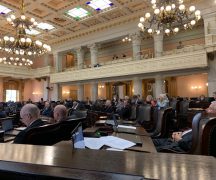BY NICK EVANS
This summer, Ohio took a big step backward when it comes to renewable energy. Lawmakers approved Senate Bill 52 which grants county officials the opportunity to intercede in the development of solar or wind projects within their borders. Now a different measure working through the House could represent a small step forward.
House Bill 450 opens the door to community solar, relatively small installations that could feed power to homes and businesses located nearby. Under the measure, sponsored by Reps. Brian Baldridge, R-Winchester, and Laura Lanese, R-Grove City, state regulators would be cleared to approve up to 3,000 megawatts of solar around the state. One megawatt of solar can power about 190 homes on average in the U.S.
Introducing the bill last month, Lanese made a wide-ranging pitch covering everything from job creation to national security, but one of the prevailing policy focuses is brownfields.
“Many of us have distressed sites in our districts be they coal ash ponds or discarded landfills sitting empty, void of economic use, and often unsightly barriers to development,” Lanese said.
She described a solar facility planned on a former landfill just south of Columbus in her district. Lanese argued the measure would allow developers around the state to turn their “lemons into lemonade.”
And the bill gives preferential treatment to those brownfield facilities. A third of the overall wattage allowance is earmarked for those developments, and each individual installation can be larger, too. While the measure caps most arrays at 10 megawatts, brownfield projects can get as large as 45 megawatts.
Rep. Baldridge bolstered that point and made a nod to the ag-preservation rhetoric that helped fuel SB 52’s passage.
“I guess my statement would be let’s utilize this legislation to promote solar on brownfields instead of cornfields,” Baldridge told committee members, “because these are brownfields that are standing there unused.”
But the bill’s sponsors have a difficult needle to thread. Although growing Ohio’s renewable energy portfolio might be good policy, SB 52 demonstrated it’s not necessarily good politics. Support for renewable energy isn’t a core tenet of GOP orthodoxy — if anything, it’s the opposite. In Ohio, grass roots organizations have mobilized quickly to oppose local renewable energy projects. They’ve trotted out criticisms about aesthetics and pleas for a “voice” in development. Other arguments have a distinct urban vs. rural tinge: Why should we risk productive farmland to help some tech firm meet its renewable energy promises?
To overcome that skepticism, Lanese insisted demand for renewable energy is broader than big tech, and that access to renewable energy sources will be an increasingly important factor as businesses decide on where to locate.
“We know that Procter and Gamble in Cincinnati wants to purchase 100% renewable power by 2030, as does Dannon Yogurt in Minster, Owens Corning in Toledo, Honeywell in Mason, and Trinity Health in Steubenville,” Lanese told members. “I can provide you a list of dozens and dozens of large and small businesses who are working nonstop to build their renewable portfolio.”
HB 450’s list of proponents includes the environmental and watchdog groups one might expect, but there’s also the Ohio Conservative Energy Forum, or OHCEF, part of nonprofit network making a renewable energy pitch aimed squarely at conservatives. Executive Director Sarah Spence described their stance as an “all of the above” approach to energy, and like Lanese, she attempted to nudge skeptics to yes by suggesting public support is broader than they might realize.
“Ohioans and companies in Ohio want renewable energy,” she said. “OHCEF’s latest polling data show that 84% of conservatives believe that Ohio should have at least 25% of its energy mix come from renewable energy sources, and that number goes to 94% with conservative voters under the age of 35.”
The measure is currently parked in the House Public Utilities Committee. It has had two hearings so far, but hasn’t been scheduled for a third.
***
Also from Ohio Capital Journal:
House committee chair presses state pharmacy board on ivermectin
An Ohio House committee chairman leaned into the director of the Ohio Board of Pharmacy Wednesday for his decision to echo a CDC warning against ivermectin as a COVID-19 treatment.
Ivermectin is a drug used as an antiparasitic in humans that conservative political and media figures have championed as a preventative and treatment for COVID-19.
Health officials at the CDC and FDA, associations of physicians and pharmacists, and the drug’s manufacturer have all warned against the use of ivermectin in connection with COVID-19. They emphasize there’s no reliable evidence to support the use of the antiparasitic in connection with the viral disease.
House State and Local Government Committee Chairman Scott Wiggam, R-Wooster, asked Board of Pharmacy Executive Director Steven Schierholt on Wednesday what kind of legislation would be needed to help Ohioans access ivermectin, even if pharmacists decline to prescribe it.
He cited an Aug. 26 OBP newsletter that re-circulated a health alert from the Centers for Disease Control and Prevention noting there’s “insufficient data” to support the use of ivermectin to treat COVID-19. READ MORE
Armed teachers bill passed out of committee
A bill allowing the arming of teachers with school board authorization passed through an Ohio House committee on Wednesday.
The House Criminal Justice Committee passed House Bill 99without any testimony, and with quick rebuff of amendments brought by Democrats.
The bill seeks to allow teachers to carry weapons with a minimum amount of training, with additional training that could be approved by school district boards of education, at their own cost. The bill came in response to a Ohio Supreme Court decision involving Butler County’s Madison Local Schools. The district authorized arming teachers after a school shooting there. READ MORE





